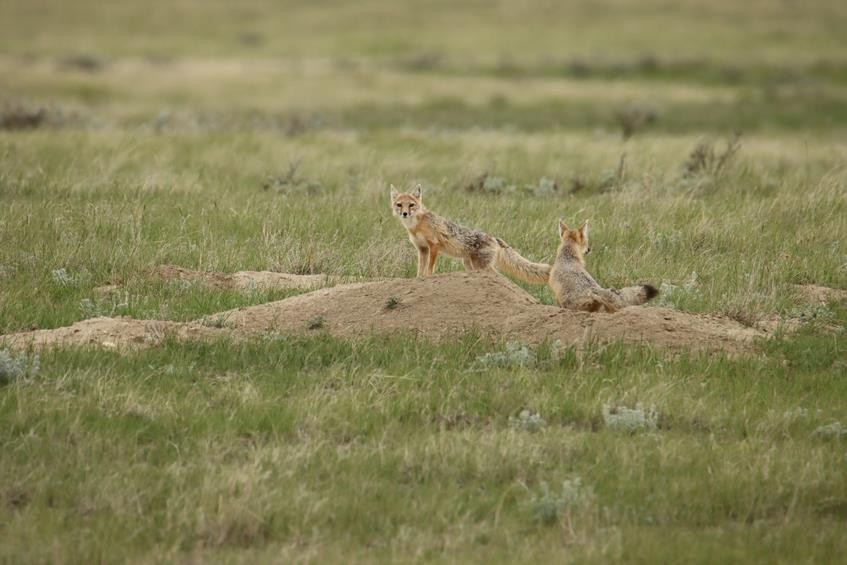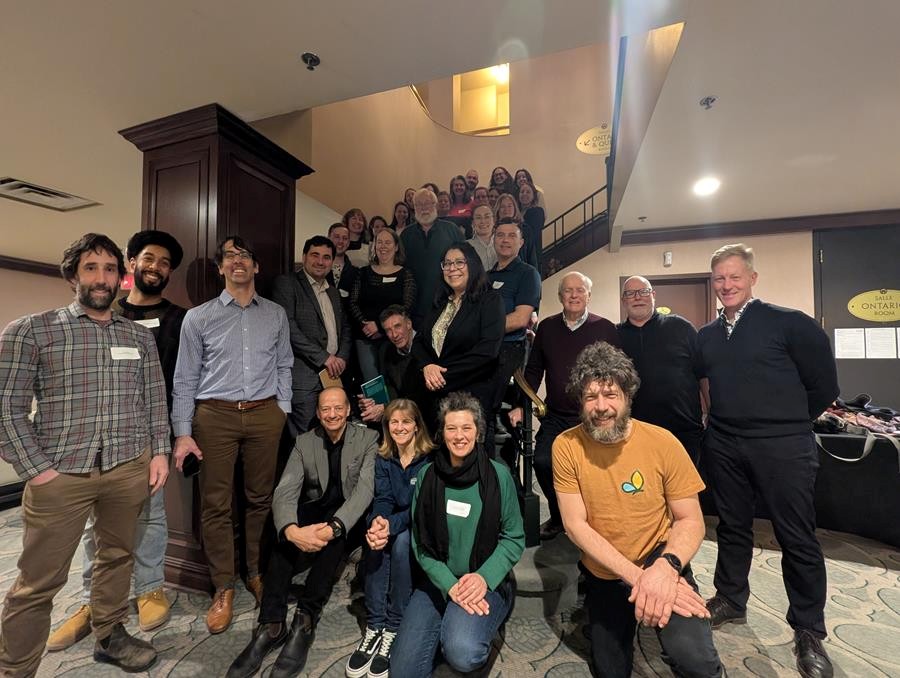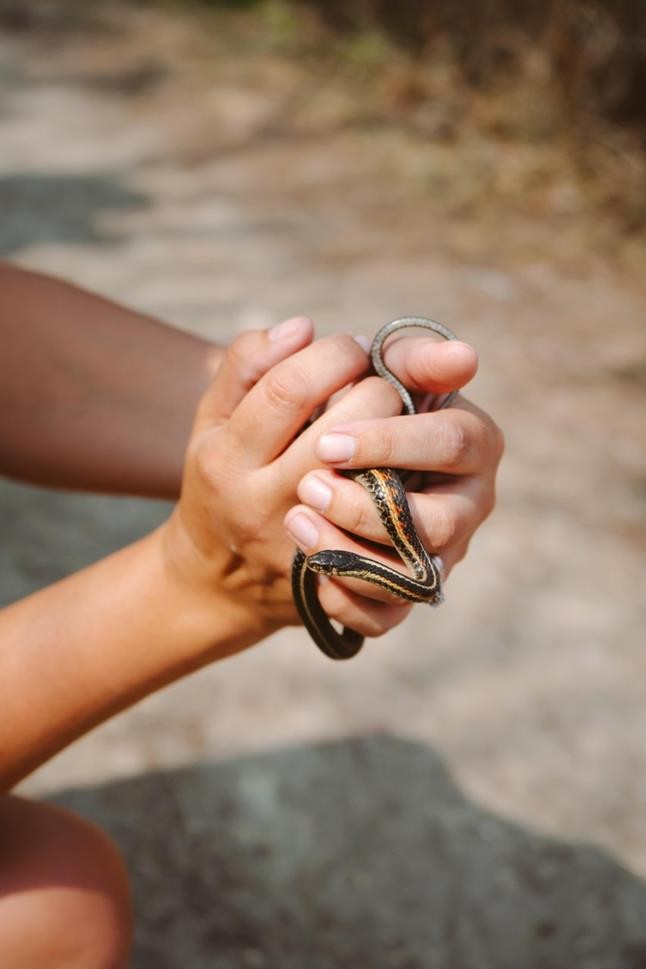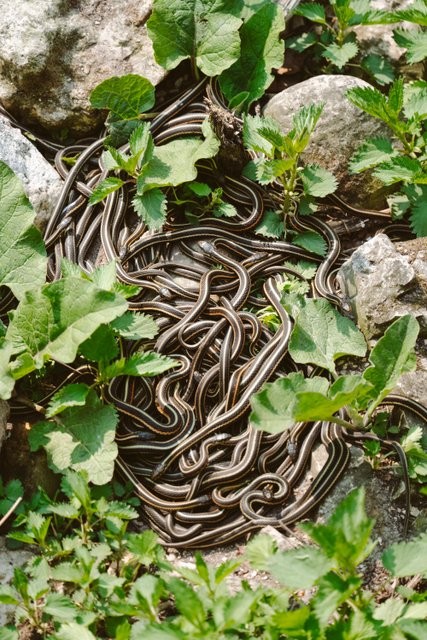
La traduction en français sera bientôt disponible – French translation coming soon
Hello everyone!
As summer begins across the country, we hope you have a chance to enjoy the incredible biodiversity that makes Canada so special – from coastal waters to forested mountains and prairie grasslands. This season brings new opportunities to observe, explore, and conserve the KBAs that support the rich natural heritage around us.
KBA partner organizations met in the late winter to take stock of progress in identifying KBAs, but mostly to discuss and establish a strategy for the next phase of the KBA program that will focus on the conservation of biodiversity in and around KBAs. Representatives from 24 organizations, governments and communities explored how KBAs can provide an effective locus for biodiversity monitoring and stewardship, how they can be used as a ready-made and credible tool to feed into land use and conservation planning as well as development decisions, and how to improve and strengthen the program to ensure that KBAs continue to be a relevant tool to support conservation work by Indigenous communities and rights holders. Participants emphasized the power of KBAs to unify conservation action across scales—from community stewardship to national policy—and called for greater awareness, long-term funding, and collaboration to ensure these sites are valued, supported, and used to drive meaningful biodiversity outcomes. A set of outcomes from the workshop will be released in the coming months, in addition to a KBA Canada strategy document that is being updated to integrate ideas from this meeting.

Photo: Representatives from 24 KBA Coalition organizations, governments and communities joined in Ottawa this February to discuss the next phase of the KBA program. Courtesy KBA Canada.
Join the KBA team!
Are you interested in joining the KBA team? Wildlife Conservation Society (WCS) Canada is seeking a British Columbia Ecosystem KBA Analyst! The ideal candidate will have a strong attention to detail, experience with mapping and analyzing ecological data using GIS and or R, and familiarity with ecosystem identification and classification. They will join WCS Canada’s dynamic KBA team, working collaboratively with the British Columbia Conservation Data Centre (BCCDC). If you are interested in applying or would like to learn more, visit the job posting here.
KBA information in action
As KBAs become more well known across Canada, we are seeing more examples of their use in conservation action and decision making. KBAs were originally embraced by the federal government as a tool to inform the placement of new protected areas. However, their utility goes far beyond protected area planning, as you can see in this recently developed table showing how KBA information can inform most of the targets of the Kunming-Montreal Global Biodiversity Framework (French version here). Here are a few recent examples of KBAs feeding into planning, prioritization, and stewardship across Canada. If you have other examples of KBAs being used, or if you’re interested in learning more about how KBAs might fit into your work, please reach out to us.
· In Nova Scotia and Newfoundland and Labrador, KBAs are highlighted in the final reports for the Regional Assessments for Offshore Wind Development, released earlier this year. The reports recognize KBAs as critical to biodiversity conservation and recommend avoiding development within these areas and nearby buffers, especially around sensitive bird habitats. They also emphasize the importance of considering bird behavior and needs outside KBAs, not just within KBA boundaries.
· The Weston Family Foundation, a major philanthropic organization in Canada, has identified KBAs as one of its top three funding priorities for environmental stewardship projects. This reflects a growing recognition among funders of KBAs as widely recognized tools for identifying critical areas for conservation that require support to steward appropriately.
· This spring, BC Nature (with funding from Chawkers Foundation) launched a KBA First Nations Caretaker Pilot. This program will adapt the Caretaker model, which has been central to the success of the IBA program for decades, to directly involve Indigenous stewardship teams. This new pilot will provide a template for directly aligning KBAs with ongoing Indigenous stewardship efforts and will build lasting relationships.
KBAs in the News
Many new KBAs have been published so far this year (see the full list below) and some are already receiving positive attention. In April, a collaborative press release from WCS Canada, Birds Canada, Alberta Wilderness Association (AWA) and Nature Saskatchewan highlighted several new KBAs in the prairies including Cypress Hills, Writing-on-Stone, and Onefour-Lost River-Sage Creek KBAs. This piece was covered in the Western Producer in May with some new comments from AWA and WCS Canada. Earlier this year several other Saskatchewan sites, including Grasslands National Park and Athabasca Sand Dunes KBAs were also featured in a February press release from WCS Canada and Birds Canada, which was covered by WestCentralOnline and other outlets in the province. Elsewhere in Canada, Wildlife Preservation Canada and WCS Canada published a press release highlighting the KBA designation for Ojibway Prairie. The Earth Day release highlighted the collaborative effort that went into identifying this KBA in southern Ontario, which is soon to be the site of a new National Urban Park. In the Kootenay region of BC, several new KBAs highlighting sites of importance for the vulnerable Northern Leopard Frog (Rocky Mountain population) and the Rocky Mountain Tailed Frog were the subject of another collaborative press release from WCS Canada and NCC, which was covered in MyEastKootenayNow.

Photo: Swift Fox are one of many species highlighted in the new set of KBAs identified in Alberta and Saskatchewan. Courtesy Chris Fisher.
In other recent publications, Canadian Geographic published a photo essay featuring photos and stories of 11 KBAs across Canada. Ciara Raudsepp-Hearne, KBA Director at WCS Canada, published an op-ed in Canadian Geographic, discussing how Canada could expand its protected area network to maximize biodiversity protection by considering KBAs and other biodiversity values of importance to Canadians. Chelsea Aristone, KBA Technician at Birds Canada, also published a blog post summarizing the recent progress in assessing Important Bird Areas (IBAs) as KBAs. The post dives into information about three IBAs that were officially accepted as KBAs within the last few months.
If you or your organization are interested in collaborating on a news release or article to spotlight a KBA and the work going on within it, please contact us.
Biodiversity Monitoring and Bioblitzes in KBAs
This summer should offer many opportunities to survey and bioblitz within KBAs. From June 1 to October 1, Blitz the Gap will be mobilizing interested volunteers in a Canada-wide community science initiative to help fill critical gaps in our biodiversity data. Anyone interested is invited to join on iNaturalist and contribute observations to any of several challenges. Challenges have been designed to help fill specific knowledge gaps that could have actionable impacts for conservation, designed by the Quantitative Biodiversity Lab at McGill University with experts including some of the KBA team at WCS Canada. Explore the challenges (including a challenge on finding new KBAs!), join a local bioblitz, and help improve understanding and stewardship of Canada’s species and ecosystems. Learn more at BlitzTheGap.org.
For those near the Cypress Hills, Alberta Wilderness Association is also hosting a bioblitz there from June 6-8. Experts with experience in monitoring in the area who are interested in joining are invited to reach out to Ruiping Luo, and everyone is invited to follow along on iNaturalist and join the public day at the Learning Center in Elkwater Townsite in Cypress Hills Interprovincial Park on June 8.
For those exploring on their own and interested in accessing lists of species that meet KBA criteria, and species and potential KBAs that need more information, check out the appendices of the 2024 Annual Report.

New eBird KBA Project with monitoring guidance for birds at KBAs
eBird recently announced that all protocols (including the IBA Protocol) have been removed and replaced by projects, and the Birds Canada KBA team has taken this opportunity to refresh KBA monitoring guidance for birds through eBird. The way surveys are done is exactly the same, but there are a few new steps in eBird to make sure your observations (when doing targeted surveys) end up in the KBA Project. See here for details and methods to do bird surveys in your local KBA! Please contact Amanda Bichel, Birds Canada KBA Coordinator if you have questions.
A thank you to all KBA Caretakers
Across Canada, many hardworking and passionate volunteers are acting as Caretakers to monitor and advocate for stewardship within IBAs and KBAs. The KBA Canada team would like recognize and thank all of these incredible individuals.
We would also like to say a special thank you to Greg Wagner, a very respected Alberta biologist and KBA Caretaker who passed away earlier this year. Greg was one of the most active Caretakers in Canada, acting as caretaker of the Frank Lake IBA/KBA for almost 15 years. His passion for birds and conservation always shone through all his work. Greg contributed over 4,000 eBird checklists for the Frank Lake over the years, teaching countless birders, photographers, and tourists about the site. He helped nominate the site as a KBA, and was instrumental in advocating for its protection in the face of development. Farewell to a true advocate, it will be hard to fill your shoes.
EBAR mapping update
The NatureServe Canada Ecosystem Based-Automated Range (EBAR) project has just wrapped up another successful (fiscal) year. See here for a few statistics about progress in developing and reviewing range maps and managing the KBA-EBAR database. The EBAR-KBA database is continuing to grow as we provide data mining and management support to various projects, including the Hudson Bay and James Bay Lowlands project with ECCC and Parks Canada. With a total of 850 range maps now available on our webpage (link), range maps for additional species of interest, including COSEWIC candidate species, are still in need of expert review. If you or someone you know would like to participate as an expert, please email us at ebar-kba@natureserve.ca
The NatureServe Canada EBAR team released a Hotspot Map that summarizes the number of EBAR species ranges (from a total of 477 published ranges included in the analysis) that intersect each Ecoshape. See image of the Hotspot Map provided and visit: https://www.natureserve.org/canada/ebar to learn more and to access the GIS data and additional documentation.

Hotspot map caption: Hotspot summary map showing the number of EBAR ranges per Ecoshape as of March 31, 2025. A total of 477 published (including high and low star rating) range maps of SARA listed (Endangered, Special Concern, Threatened, or Extirpated) and/or COSEWIC assessed (Endangered, Special Concern, Threatened, Extirpated, Extinct or Data Deficient) species were included in the analysis. Eco Shapes with a darker red coloration indicate areas with a higher count of EBAR ranges that intersect the Ecoshape (i.e., higher count of species known to be present, historically present, or expected to be present within the Ecoshape).
KBA of the Season – Spring!
Name: Narcisse
Location: Manitoba, Ontario
Tucked into Manitoba’s Interlake Plain, Narcisse is a remarkable landscape of ridges, swales, and limestone caves carved by centuries of water flow. This unique mix of open meadows, aspen and spruce forests, and wetlands sets the stage for one of nature’s most fascinating spectacles. Every year, typically around Mothers Day, thousands of Common Garter Snake (Thamnophis sirtalis) gather here in what’s believed to be the largest gathering of snakes of any kind on the planet. This incredible global phenomenon at Narcisse is the result of a unique combination of geography, geology, and climate, and is a must-see for wildlife lovers and curious minds alike.

Photo Credit: Travel Manitoba
Species of the Month!
Name: Common Gartersnake (Thamnophis sirtalis)
Habitat: Narcisse, Manitoba
Spring marks the return of one of North America’s most familiar reptiles—the Common Garter Snake, easily recognized by their sleek dark body and colorful yellow stripes. As temperatures rise in the spring, snakes emerge from hibernation and become more active, and the Common Garter is the most commonly encountered snake in most parts of its range. The greatest threat to this snake is road mortality, so as you travel this summer keep a keen eye out for these snakes!

Photo: Travel Manitoba
New KBA Sites!
· Anchor Point (Newfoundland and Labrador): https://kbacanada.org/site/?SiteCode=NL088
· Bateau Barrens (Newfoundland and Labrador): https://kbacanada.org/site/?SiteCode=NL089
· Brig Bay (Newfoundland and Labrador): https://kbacanada.org/site/?SiteCode=NL090
· Burnt Cape (Newfoundland and Labrador): https://kbacanada.org/site/?SiteCode=NL091
· Green Island Brook (Newfoundland and Labrador): https://kbacanada.org/site/?SiteCode=NL092
· K’ómoks (British Columbia): https://kbacanada.org/site/?SiteCode=BC272
· Pointe-Sapin (New Brunswick): https://kbacanada.org/site/?SiteCode=NB042
· Port au Choix (Newfoundland and Labrador): https://kbacanada.org/site/?SiteCode=NL093
· Sandy Cove Airstrip (Newfoundland and Labrador): https://kbacanada.org/site/?SiteCode=NL094
· Sandy Cove Ecological Reserve (Newfoundland and Labrador): https://kbacanada.org/site/?SiteCode=NL095
· Shoal Cove (Newfoundland and Labrador): https://kbacanada.org/site/?SiteCode=NL096
· The Tablelands (Newfoundland and Labrador): https://kbacanada.org/site/?SiteCode=NL100
· Wagon Creek Road (Manitoba): https://kbacanada.org/site/?SiteCode=MB128
· Watts Point to Cape Norman (Newfoundland and Labrador): https://kbacanada.org/site/?SiteCode=NL097
· Yankee Point (Newfoundland and Labrador): https://kbacanada.org/site/?SiteCode=NL098
· Big Muddy Lake (Saskatchewan): https://kbacanada.org/site/?SiteCode=SK018
· Cape St. Francis (Newfoundland and Labrador): https://kbacanada.org/site/?SiteCode=NL021
· Chaplin Lake (Saskatchewan): https://kbacanada.org/site/?SiteCode=SK033
· Coteau Lakes (Saskatchewan): https://kbacanada.org/site/?SiteCode=SK017
· Country Island Complex (Nova Scotia): https://kbacanada.org/site/?SiteCode=NS028
· East Lake Diefenbaker (Saskatchewan): https://kbacanada.org/site/?SiteCode=SK055
· Eastern Shore Islands (Nova Scotia): https://kbacanada.org/site/?SiteCode=NS027
· Grand Colombier Island (Newfoundland and Labrador): https://kbacanada.org/site/?SiteCode=NL03
· Green Island (Newfoundland and Labrador): https://kbacanada.org/site/?SiteCode=NL032
· Lavallée Lake (Saskatchewan): https://kbacanada.org/site/?SiteCode=SK004
· Luck Lake (Saskatchewan): https://kbacanada.org/site/?SiteCode=SK003
· Middle Lawn Island (Newfoundland and Labrador): https://kbacanada.org/site/?SiteCode=NL03
· Mistaken Point (Newfoundland and Labrador): https://kbacanada.org/site/?SiteCode=NL024
· Ormiston Area Saline Lakes (Saskatchewan): https://kbacanada.org/site/?SiteCode=SK029
· Point Amour, Strait of Belle Isle (Newfoundland and Labrador): https://kbacanada.org/site/?SiteCode=NL068
· Quidi Vidi Lake and Area (Newfoundland and Labrador): https://kbacanada.org/site/?SiteCode=NL022
· Wadham Islands and Marine Area (Newfoundland and Labrador): https://kbacanada.org/site/?SiteCode=NL013
· Willow Bunch Lake (Saskatchewan): https://kbacanada.org/site/?SiteCode=SK020
· Balabas Island (Manitoba): https://kbacanada.org/site/?SiteCode=MB099
· Big Stick – Crane Lake Sandhills (Saskatchewan): https://kbacanada.org/site/?SiteCode=SK13
· Cypress Hills (Saskatchewan): https://kbacanada.org/site/?SiteCode=SK137
· Douglas Provincial Park – Elbow Sandhills (Saskatchewan): https://kbacanada.org/site/?SiteCode=SK139
· Elder Creek (British Columbia): https://kbacanada.org/site/?SiteCode=BC312
· Milk River-Pinhorn (Alberta): https://kbacanada.org/site/?SiteCode=AB004
· Onefour-Lost River-Sage Creek (Alberta): https://kbacanada.org/site/?SiteCode=AB065
· Prairie Pastures (Saskatchewan): https://kbacanada.org/site/?SiteCode=SK039
· Central Selkirks (British Columbia): https://kbacanada.org/site/?SiteCode=BC319
· Funk Island (Newfoundland and Labrador): https://kbacanada.org/site/?SiteCode=NL004
· Lake Winnipeg Island Chain – Sandy to George (Manitoba): https://kbacanada.org/site/?SiteCode=MB062
· North Lake Winnipegosis Reefs (Manitoba): https://kbacanada.org/site/?SiteCode=MB102
· Pakowki Lake and Sandhills (Alberta): https://kbacanada.org/site/?SiteCode=AB064
· Ross Lake (Alberta): https://kbacanada.org/site/?SiteCode=AB138
· Tonquin (Alberta): https://kbacanada.org/site/?SiteCode=AB139
· Carden Alvar (Ontario): https://kbacanada.org/site/?SiteCode=ON040
· Castle-Waterton-Akamina (Alberta): https://kbacanada.org/site/?SiteCode=AB136
· Delta Marsh (Manitoba): https://kbacanada.org/site/?SiteCode=MB001
· Prince Edward County South Shore (Ontario): https://kbacanada.org/site/?SiteCode=ON003
· Sable Island National Park Reserve (Nova Scotia): https://kbacanada.org/site/?SiteCode=NS025
· Western PEI Sand Hills (Prince Edward Island): https://kbacanada.org/site/?SiteCode=PE023
· Great Sandhills (Saskatchewan): https://kbacanada.org/site/?SiteCode=SK135
· PEI National Park (Prince Edward Island): https://kbacanada.org/site/?SiteCode=PE013
· Bangs Falls (Nova Scotia): https://kbacanada.org/site/?SiteCode=NS086
· Barren Hill Lake (Nova Scotia): https://kbacanada.org/site/?SiteCode=NS087
· Bishops Lake (Nova Scotia): https://kbacanada.org/site/?SiteCode=NS088
· Cape Split (Nova Scotia): https://kbacanada.org/site/?SiteCode=NS089
· Caribou Barrens (Nova Scotia): https://kbacanada.org/site/?SiteCode=NS090
· Elk Island National Park (Alberta): https://kbacanada.org/site/?SiteCode=AB137
· Forresters Lake (Nova Scotia): https://kbacanada.org/site/?SiteCode=NS091
· Foxey Prairie-Gore Bay Alvar (Ontario): https://kbacanada.org/site/?SiteCode=ON199
· LaHave River (Nova Scotia): https://kbacanada.org/site/?SiteCode=NS093
· Lake Huron North Channel Islands (Ontario): https://kbacanada.org/site/?SiteCode=ON200
· Living Prairie Museum (Manitoba): https://kbacanada.org/site/?SiteCode=MB130
· Lower Detroit River (Ontario): https://kbacanada.org/site/?SiteCode=ON047
· Napanee Limestone Plain (Ontario): https://kbacanada.org/site/?SiteCode=ON152
· Petite Rivière Lakes (Nova Scotia): https://kbacanada.org/site/?SiteCode=NS094
· Pottle Lake (Nova Scotia): https://kbacanada.org/site/?SiteCode=NS095
· Shoal Lakes Plains (Manitoba): https://kbacanada.org/site/?SiteCode=MB038
· Stuartburn-Vita Tall Grass Prairie (Manitoba): https://kbacanada.org/site/?SiteCode=MB131
· Sydney River (Nova Scotia): https://kbacanada.org/site/?SiteCode=NS097
· Tolstoi-Gardenton Tall Grass Prairie (Manitoba): https://kbacanada.org/site/?SiteCode=MB132
· Upper Chignecto Bay (New Brunswick): https://kbacanada.org/site/?SiteCode=NB043
· Upper Medway Lakes and Wetlands (Nova Scotia): https://kbacanada.org/site/?SiteCode=NS098
New versions of the following sites were published on the Registry:
• Brier Island and Offshore Waters (Nova Scotia): https://kbacanada.org/site/?SiteCode=NS021
• K’ómoks (British Columbia): https://kbacanada.org/site/?SiteCode=BC272
• Kluane National Park and Reserve: Dezadeash-Kaskawulsh Confluence (Yukon): https://kbacanada.org/site/?SiteCode=YK034
• Kusawa Territorial Park: Takhini River (Yukon): https://kbacanada.org/site/?SiteCode=YK037
• Minto (Yukon): https://kbacanada.org/site/?SiteCode=YK047
• Ross River (Yukon): https://kbacanada.org/site/?SiteCode=YK048[SP1]